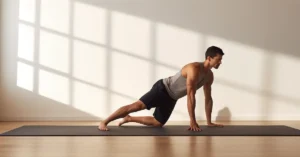📦 FREE Shipping
7 Essential Endurance Swim Workouts 2024 (You will love all)

Swimming is an excellent exercise for boosting cardiovascular health, and incorporating endurance swim workouts into my routine has been a game changer for my fitness level. These workouts are designed not just to challenge my body but to improve my stamina and overall swimming endurance.
I find that a dedicated swim session focusing on longer distances at a steady pace can significantly increase my ability to swim for longer periods without tiring. It’s a gratifying and meditative practice that adds variety to my workouts, keeps me engaged, and pushes my limits in the water.
7 Essential Endurance Swim Workouts
Endurance swim workouts are my go-to for boosting performance and energy in long-distance swimming. They’re designed to enhance my cardio capacity and muscular endurance, vital for every race from middle distance to marathon swims. My emphasis is on both distance-based sets for sustained swimming and speed and stamina-building sets for a powerful performance.
1. The Distance Challenger
- Warm-up: Start with a 400-meter easy freestyle swim to prepare your body for the workout.
- Main Set: Challenge yourself with 5 sets of 1000 meters of freestyle swimming, with a 20-second rest between each set. This workout will push your endurance to the limit.
- Cool-down: Finish with a 200-meter easy swim in your choice of stroke to cool down and aid recovery.
2. Open Water Simulation
- Warm-up: Begin with a 300-meter easy freestyle swim to warm up your muscles.
- Main Set: Simulate open water conditions by doing 4 sets of 500 meters of freestyle swimming. Practice sighting every 6 strokes as if you were navigating open water. This will improve your open water swimming skills.
- Cool-down: Conclude with a 200-meter easy swim in your choice of stroke.
3. Pyramid Power
- Warm-up: Kick things off with a 400-meter easy freestyle swim to get your body ready.
- Main Set: Challenge your endurance with a pyramid-style set. Start with a 100-meter swim, then increase the distance in increments (200m, 300m, 400m), and then work your way back down (300m, 200m, 100m). Rest for 15 seconds between each set.
- Cool-down: Finish with a 200-meter easy swim in your choice of stroke.
4. Interval Intensity
- Warm-up: Start with a 400-meter easy freestyle swim to prepare for the main set.
- Main Set: This workout focuses on interval training. Perform 10 sets of 200 meters of freestyle swimming, aiming to finish each 200-meter swim within a set time frame (e.g., 2 minutes and 30 seconds). Adjust the interval as needed based on your skill level.
- Cool-down: Conclude with a 200-meter easy swim in your choice of stroke.
5. The Ironman Prep
- Warm-up: Begin with a 500-meter easy freestyle swim to warm up thoroughly.
- Main Set: Prepare for long-distance swimming by doing 3 sets of 1500 meters of freestyle swimming. Rest for 30 seconds between each set.
- Cool-down: Finish with a 300-meter easy swim in your choice of stroke.
6. Kick and Pull Combo
- Warm-up: Start with a 300-meter easy freestyle swim to get your body ready.
- Main Set: Improve your technique and build endurance with 10 sets of 200 meters. Alternate between kicking and pulling with a pull buoy. Do 5 sets of each, with 15 seconds of rest between sets.
- Cool-down: Conclude with a 200-meter easy swim in your choice of stroke.
7. The Ocean Explorer
- Warm-up: Begin with a 400-meter easy freestyle swim to warm up and get your muscles ready.
- Main Set: Challenge yourself with a continuous 60-minute swim at a steady pace. Focus on maintaining efficient, long strokes. This workout simulates the endurance needed for open water or long-distance swimming.
- Cool-down: Finish with a 200-meter easy swim in your choice of stroke to aid recovery.
Remember to stay hydrated, monitor your form and breathing, and adjust the workouts to match your current fitness level. Consistency and gradual progression are key to improving your endurance swim workouts.

Swimming Equipment for Endurance
When I execute endurance swim workouts, I make sure to incorporate various pieces of equipment that are designed to improve strength and stamina. Here’s how I make the most of these tools.
Training With Tools
Kickboard: I use a kickboard to isolate my legs, ensuring they get a strenuous workout and increase in power. This helps improve my kicking endurance, which is essential for long swims and endurance swim workouts.
Paddles and Fins: Swim paddles are an excellent way to develop upper body strength, focusing on my arm pull. Fins add resistance to my kicks, simulating longer workout conditions and helping me to build leg endurance.
Pull Buoys: On days focusing on my upper body, I use a pull buoy between my thighs. This flotation device helps me to maintain buoyancy without kicking, allowing me to concentrate on my stroke endurance and technique.

Injury Prevention and Recovery
Stretching and Strength Training Tools: Post-swim, I employ stretching straps and a kettlebell. The stretching straps help me to maintain flexibility, while the kettlebell is great for a full-body strength workout that supports injury prevention.
Recovery: After rigorous endurance sessions, I use foam rollers and massage balls to aid in my recovery process. These tools help reduce muscle soreness and speed up recovery, so I can return to training sooner.
Fundamentals of Endurance Swimming
Building endurance in swimming involves a nuanced understanding of the body’s physical limits and the ways to enhance its performance. I’ll explore the mechanics of endurance and the interconnected roles of cardiovascular fitness and heart rate.
Understanding Endurance in Swimming
When I talk about endurance in swimming, I’m referring to my ability to sustain swimming over extended periods or distances. This capacity is not just about muscle strength; it’s also about how efficiently my body uses oxygen, which is delivered to my muscles by the heart and lungs. The key to improving my endurance is through consistent endurance swim workouts that focus on both technique and stamina.
The Role of Fitness and Heart Rate
My overall fitness level is deeply intertwined with my cardiovascular fitness. When I develop my cardiovascular system through endurance training, I’m essentially strengthening my heart muscle and improving the oxygen-carrying capacity of my lungs. Monitoring my heart rate is crucial in this process, as it provides me with real-time feedback on the intensity of my workout. By training at different heart rate zones, I can enhance my endurance without overtraining or undertraining.

Endurance Training Techniques
In my endurance swim workouts, I’ve found that focusing on two key areas makes a significant difference in endurance: interval training with pace work, and honing my technique with specific drills. These approaches help me target my cardiovascular fitness and enhance my stroke efficiency.
Interval Training and Pace Work
Interval training is the backbone of my endurance regimen. Here’s what I typically include in a session:
- Warm-Up: I start with a 400-meter easy swim to get my muscles loose.
- Main Set: This might consist of multiple sets with varied distances, for instance:
- 4 x 200 meters at a moderately challenging pace, followed by 30 seconds of rest.
- 8 x 100 meters: I try to maintain or slightly increase my pace with each 100 meters, taking 20 seconds of rest in between.
The key to interval training is to track my pace. I always aim to keep it consistent or improve it slightly with each repetition. Monitoring my stroke rate and ensuring my breathing pattern remains steady are also crucial elements to the endurance swim workouts’ success.
Technique Drills and Form Improvement
Improving my form and stroke efficiency is just as important as the work I put into building endurance. To enhance my technique, these drills are part of my routine in my endurance swim workouts:
- Catch-Up Drill: It helps me focus on one arm at a time, making sure each stroke is powerful and efficient.
- 3-3-3 Drill: For this drill, I do three strokes with one arm, then three with the other, followed by three full strokes. This encourages better bilateral breathing and symmetry in my stroke.
I also pay close attention to maintaining a steady stroke rate while focusing on my technique. This ensures I’m not sacrificing form for speed, which can be a common pitfall as fatigue sets in.

Advanced Endurance Strategies
In my journey as a swimmer, I’ve found that advanced endurance strategies involve meticulous planning and regular performance evaluations. These are key for anyone looking to excel in the pool, whether you’re a seasoned triathlete or a coach guiding competitive swimmers.
Developing a Personalized Swim Plan
Creating a personalized swim plan is essential. I start by establishing clear goals and mapping out a training plan that targets specific endurance milestones. For instance, I might structure my swim plan around building up to 5,000 meters, incrementing the distance each week. Here’s how I breakdown a typical week:
- Monday: Threshold sets (e.g., 4×500 meters at race pace)
- Wednesday: Speed and technique drills (shorter distances, high intensity)
- Friday: Long, steady-state swims (e.g., 2×1500 meters at a moderate pace)
As a coach, I advise swimmers to design their plans around their lifestyle, ensuring they can stay consistent without burning out.
Monitoring Progress and Adjustments
Keeping a journal to track my progress is something I consider non-negotiable. It’s not just about recording times and distances; it’s also about how my body feels after endurance swim workouts and noting any areas that require additional focus. When adjustments are needed, I do so methodically. For example, if I notice my times are plateauing, I might intensify the interval training within my swimming workouts. Feedback is a critical component here, and if you’re a coach, providing timely feedback to your swimmers can make all the difference.
My experience with Endurance Swim Workouts
During my swimming journey, I’ve found that integrating endurance swim workouts into my routine has been a game-changer. I remember when I first added a swimming endurance workout during a particularly tough week; it surprisingly helped my recovery. Not only did my stamina improve, but so did my ability to clear lactic acid from intense sessions.
Typically, I commit to sets that progressively increase in length. Here’s a sample of how I structure it:
- Set 1: 4×100m freestyle, 30s rest
- Set 2: 4×200m freestyle, 45s rest
- Set 3: 4×400m freestyle, 60s rest
Incorporating equipment, like fins or paddles, into my endurance swim workouts is also something I’ve found beneficial, especially for building strength. This, in turn, naturally enhances my endurance. Using tools not only provides variety but also introduces new challenges. If I like a little change, I do CrossFit Swim Workouts here and there.
Through trial and error, I’ve tailored my endurance workouts to what works best for me. The feeling of being able to swim longer and stronger is a testament to the effectiveness of these workouts. Each session is a step forward in my swimming capabilities.
Frequently asked questions about Endurance Swim Workouts
How do you train endurance for swimming?
To train endurance swim workouts, I start by incorporating a mix of long distance sets at a moderate pace and shorter intervals with rest periods. For example, swimming a series of 15×200 meter freestyles with 30 seconds rest can be an effective approach to building stamina.
How can I increase my stamina for swimming?
To increase my stamina, I ensure that I am steadily increasing the length of my endurance swim workouts and incorporating interval training as well as drills that focus on technique. Consistent practice and pushing my limits a little further each time help build stamina effectively. Also, I focus on maintaining a balanced diet that aids in improved cardiovascular fitness.
What is considered endurance swimming?
Endurance swim workouts typically refer to swimming a long distance continuously and at a consistent pace. It’s often about covering distances of over 1500 meters without stopping, aiming to maintain a steady speed throughout.
How do you train for a 10km swim?
Training for a 10km swim involves a strategic and progressive plan. I start with a solid foundation of swimming fitness and then gradually increase my weekly mileage. I include long endurance swim workouts each week that gets progressively longer, mixed in with shorter recovery swims and technique work. Phase-wise training is essential to build up to such a demanding race.
How can I swim 1km without stopping?
To swim 1km without stopping, I focus on a gradual build-up in distance during my endurance swim workouts. I also ensure that I am working on my technique to improve efficiency in the water, as well as incorporating breathing exercises to control my breath. It’s crucial to maintain a relaxed and steady pace to conserve energy throughout the swim.
If you liked these Endurance Swimming Workouts make sure to also check my CrossFit Track Workouts and the Pamela Reif Workout Plan to get an excellent core.





